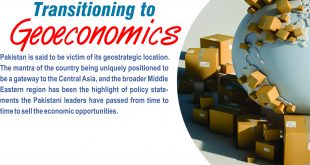By: Raashid Wali Janjua
What Pakistan needs do to cope with the menace?
Recently, while speaking at the annual internship programme held at the ISPR Directorate, the Chief of Army Staff General Qamar Javed Bajwa highlighted the issue of hybrid warfare and said that the nature and the character of war have changed now and in today’s age of hybrid warfare, Pakistan’s youth is the prime target of its enemies. He advised the youth to stay determined and defeat all such threats to take Pakistan forward to its rightful destination. These remarks by the COAS vividly show that there is a greater realization of this new form of war in the higher echelons of Pakistan army, and it is also well aware of the need to cope with the menace, which is among the most critical challenges Pakistan will be facing in the near future.
The technological development and the instant communication possibilities advanced not only economic and social developments, but also evolving threats from those who exploit the vulnerabilities of communication and information systems. In the ever-evolving geopolitical environments and pre-eminence of trends like economy, media, civil society and globalization, the scope of waging a sole conventional war is neither feasible nor cost effective. This notion has given rise to the concept of Hybrid Warfare with the accruing benefits of ambiguity, surprise and, above all, cost efficiency.
The term hybrid warfare refers to a non-linear conflict, where the state actors in addition to kinetic or military forces employ non-kinetic means like cyber-attacks, politico-economic subversion, psychological warfare and diplomatic pressure to bring an adversary to heel. Williamson Murray elucidates the concept of hybrid warfare in his book ‘Hybrid Warfare: Fighting complex opponents from the ancient world to the present’, through nine case studies of such conflicts. Starting from the defeat of Rome in 9 AD when Germanic tribes decimated three Roman Legions in the Teutoburg Forest through clever use of wooded terrain and unconventional ambuscades; to the Nine Years’ War in Ireland in the late 16th and early 17th centuries, as well as the American War of Independence and the Vietnam War, there are many examples of hybrid wars in this book, where the regular forces were complemented by the use of guerrillas and partisans to attack the rival resistance on multiple fronts.
Sometimes, the term ‘fourth generation warfare’, initially introduced by William S. Lind, is also used interchangeably with hybrid warfare due to the protean nature of the threats and their interplay in attainments of strategic objectives. Fourth generation warfare however, is distinguished from hybrid warfare by the involvement of non-state actors pitted against a traditional army. They present a decentralised, non-hierarchical, and non-traditional structure of threat. Contrarily – in hybrid warfare – wars are fought between states using non-linear tactics involving all elements of national power. A recent example is the Russian annexation of Crimea, where Russians very cleverly exploited their irredentist claim over Crimea along with fomenting unrest in Eastern Ukraine, leaving NATO and the US with limited military options. In 1971, a hybrid war was successfully executed by India against a beleaguered Pakistani military force in erstwhile East Pakistan.
Read More: Information Warfare
Today, history is repeating itself, as India is imposing yet another hybrid war on Pakistan. The strategy this time is to bleed us through a thousand cuts instead of the much-touted rapier like air and ground thrusts, which was a strategy in line with their airy-fairy Cold Start Doctrine. In this new hybrid war, India is being tacitly encouraged by her strategic allies who view South Asia through the prism of a new Cold War. CPEC is being perceived as a new red rag to the paranoid neurosis of the “Get China” camp, which views the Belt and Road Initiative as a manifestation of China’s global imperialism. Unfortunately for South Asia, India – supposedly the land of the sages – has fallen hook, line and sinker for the Western narrative, forsaking the geo-economics of regional connectivity for the geopolitics of big power alliances and influence-peddling. Indians must ponder what they stand to gain as a country by latching on to a bandwagon of distant world powers, against cooperation with a regionally contiguous emerging global economic force — but it is evident beyond a shred of a doubt that such confrontation will impact the economic development of both India and Pakistan negatively.
Nevertheless, this hybrid warfare is an existential threat that needs to be understood by Islamabad in all its kinetic, ontological and epistemic dimensions in order to mount an effective response. Pakistan is a victim of a complex threat spectrum that includes border violations, smuggling, terrorism, irredentist claims by Afghanistan, diplomatic coercion, economic subversion and internal destabilisation. Beset with the above threats, the country needs strong leadership and institutional harmony. The fractious polity of the country itself is a liability. It offers several vulnerabilities to Pakistan’s foes, who exploit political greed, ethnic particularism and inter-institutional disharmony to keep the country embroiled in debilitating progress. This phenomenon has already taken a heavy toll on our political and economic progress. The lack of political harmony, civil-military discord and corruption are adversely affecting our human development, keeping countless Pakistanis mired in abject poverty and destitution. In addition, the constant territorial threats force Pakistan to keep a large conventional as well as nuclear deterrence, imposing heavy strain on its fragile economy.
A question that begs answer here is whether or not a hybrid war can be fought with our present political and governance structure? Another related question that emerges is whether we require a ‘hybrid democracy’ to fight a hybrid war? The answers are hard to find unless we think out of the box. Hybrid democracy, as per Robert Kaplan, is akin to enlightened despotism, wherein the military supports a political head of government who is not prone to parliamentary vulnerabilities like pleasing voters and keeping a polyglot ethnic mix reconciled as per their competing interests. He quotes the philosopher Warrington, who disparages democracy as a ‘debate in a crowd’ and declares it consequently unsuitable for effective governance in countries riven by ethnic and tribal differences. He cites the unelected era of Moeen Qureshi in 1993 in his article ‘Was Democracy Just a Moment’ published in a December 1997 issue of a US magazine, The Atlantic, as the most stable era, where the government took effective steps for administrative and economic reforms, untrammelled by the shackles of partisan politics.
Robert Kaplan quotes Lee Kwan Yu’s example under whose authoritarian rule Singapore evolved into a corporation that was “paternalistic, meritocratic and decidedly undemocratic” forging prosperity from abject poverty. As per Jeffrey Sachs, a professor of international trade at Harvard, “good government” means safety from corruption, breach of contract, property expropriation, and bureaucratic inefficiency. Many of the above elements are present in Pakistan’s democratic governance that are circumscribing the country’s governance efficiency. This lack of political consensus has prevented the construction of big dams, imperilling our food security. The country is suffering from political and economic polarization due to lack of development in areas like Balochistan, where the voter incentive is insufficient for inducing voter chasing behaviour in the government. The continual need to appease the avaricious members of parliament — who represent feudal and business oligarchies — keeps the government in a state of paralysis, incapable of taking bold decisions in the interests of the country.
Now, what we have here in Pakistan is a hybrid war, imposed upon a poorly functional state where apart from the army and judiciary, no institution dares question the rampant corruption and poor governance threatening human as well as national security. Assailed from multiple directions through multiple stratagems like trade wars, economic pressures, terrorism, ethnic uprisings and diplomatic isolation, the country fails to mount a strong response because of the structural weaknesses of an effete democracy. The answer might just lie in a Hybrid Democracy, wherein the army and judiciary work together to create a stable executive, untrammelled by the compulsions of voter politics. Hybrid wars are difficult to win without a hybrid democracy for developing countries, a fact that is evident from the many examples of developing countries where a lack of strong leadership has resulted in chaos and the political meltdown of states.
RAW’s hybrid War against Pakistan
Indian intelligence agency Research & Analysis Wing (RAW) has been, of late, involved in heightened hybrid warfare against Pakistan. RAW is trying its best to isolate Pakistan from the world and as per reports from the Indian media, it has been given an unlimited and unaudited budget against Pakistan. There is a special allocation of budget to RAW for the isolation and disability of Balochistan in order to discredit Pakistan eventually. Through hybrid wars against Pakistan, RAW wants to achieve the following purposes:
1. Isolation of Pakistan internationally
2. Attempt to get declared Pakistan a terrorist state and sponsor of money laundering/ terrorist financing.
3. Attack on Pakistan through cyber network and RAW-sponsored anti-Pakistan campaigns through TV/ film and books through their motivated intellectual brainwashing.
4. Build pressure on eastern boarder through Cold Start Doctrine and western borders through their partner NDS.
5. Creating unrest in Balochistan and KP and to energize the conspiracy of breaking Pakistan as announced by the Defence Minister of India, duly endorsed by no less than PM Modi.
In 2013, Indian Army Chief General Vijay Kumar Singh admitted that following the 2008 Mumbai attacks, the Indian army raised a Tactical Support Division (TSD), which carried out bomb blasts in Pakistan, and doled out money to separatist elements in Balochistan. Solid evidence of Indian clandestine activities was discovered in March 2016 when Pakistan’s intelligence and security agencies unearthed the largest RAW network to date, which had been involved in carrying out terrorist activities. Leading this network was the now infamous Kulbushan Jadhav, an Indian Navy commissioned officer, who was arrested by Pakistan Army operating from the Pakistan-Iran border area. He was arrested in 2016 in Balochistan, giving proof of this international conspiracy against Pakistan. The man himself confessed that many other agents like him have been deployed by the RAW in Karachi and other areas of Pakistan to spread terrorism across the country. Furthermore, he also confessed to being assigned by RAW “to plan and organize espionage and sabotage activities” in the Balochistan province and Karachi, the southern port city that is the country’s commercial hub.
An example of this warfare can be found in the Uri false flag operation. On 8th September 2016, Indian RAW orchestrated a fake attack on its Uri base close to LOC with Pakistan and like all other previous attacks following the same old strategy, they put blame on Pakistan for it. It was actually a “blatant” attempt to divert attention from the fast deteriorating human rights situation in the India-Occupied Kashmir since the death of Burhan Wani.
 Jahangir's World Times First Comprehensive Magazine for students/teachers of competitive exams and general readers as well.
Jahangir's World Times First Comprehensive Magazine for students/teachers of competitive exams and general readers as well.



